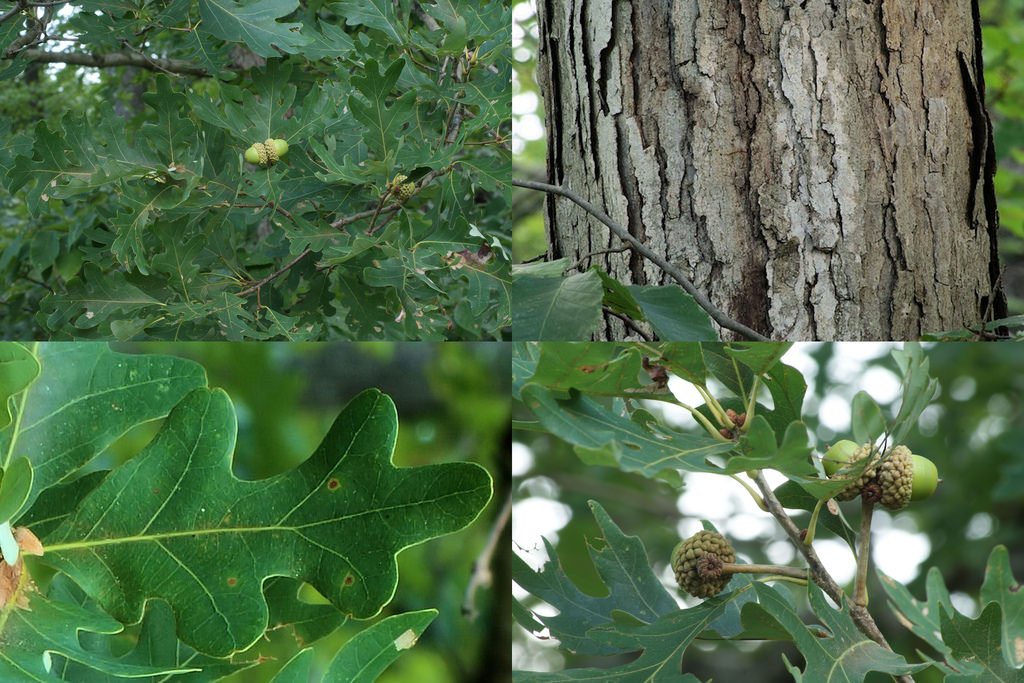White Oak
Quercus alba L.
Description
White oak is a member of the beech family (Fagaceae). It is a hardwood that typically grows to a height between 80-100 feet, with a trunk that is 3-4 feet in diameter, and has a large, round crown. The bark is rough with a light gray color from which it gets its name. The tree has simple leaves that are arranged alternately on the branches. The leaves are between 4-6 inches long, with deep, rounded lobes that are even around the edges and a wedge-shaped bottom. The leaves are green on the top and whitened on the bottom. White oak trees produce unisex flowers at different times in the spring, so the trees cannot self-pollinate. The male flowers are yellow-green catkins about 2-4 inches long. The female flowers are reddish-green spikes that grow in mid-spring with the leaves9. The fruit produced are oval acorns that grow with large, bowl shaped caps that cover ¼ of the nut before the nut falls, without the cap, in the fall2,4,5,7,8.

White oak leaves, bark and acorns. B. Harms, Maryland Biodiversity Project 13
Distribution
White oaks are distributed through the eastern United States and Canada. Because these trees need a lot of sunlight, they do not occur in dense forests with a lot of competition8. White oak tends to be in lowland areas to upland slopes, but do not grow at very high elevations8. They prefer dry to moderate soil moisture. Maryland has about 2.5 million acres of forest land. White oak is the fourth most common tree with 540 million cubic feet of saw timber and is found in every forest in Maryland12.

Native range of white oak. USDA9
Wildlife Importance
The acorns of these trees are important parts of diets for many birds, including blue jays, crows, woodpeckers, turkeys and ducks. The acorns are also part of an important diet for many woodland mammals, including squirrels, chipmunks, mice, racoons, and deer8. The trees provide shelter and food source of many species of moths, caterpillars, stick bugs, and other insects. Because of the tree’s host to many insects, it provides food to many other birds that will feed on the insects and feed their young10. The white oak is also being used in reforestation projects because they have an ability to adapt to different kinds of soils with a range of pH from 5.5-8.0 and different textures from clay to loamy³.
Economic Importance
Because the wood of the white oak is durable, it is used in railroad ties, fenceposts, mine timbers, ships, and caskets. Currently it is the major source of wood used in whiskey wine barrels. It is commercially used for lumber, flooring, and other interior woodwork³.
Threats
Many white oak forests loose much of their leaves due to an invasive species of moths, the gypsy moth. The caterpillars of this moth defoliate the trees at dangerous levels, where the trees cannot recover. Melissopus latiferreanus and Valentinia glandulella moths as well as the Cynipid wasp, cause damage to the acorns of adult trees, preventing reproduction. White oak is also threatened by species of fungi called anthracnose, oak wilt, and oak leaf blister¹. Excessive grazing of young trees by rabbits, deer, porcupines, and beavers can girdle stems and cause the young trees to halt growing9. Quercus alba are also particularly sensitive to disturbances in root zones8. The tree is very sensitive to changes to ground water caused by humans when they dig, pave, or trench near the trees10. Because the need for lots of sunlight, many young trees have trouble living to adulthood because the large crowns of the other trees will block sunlight from reaching the forest floor.
Interesting Facts
- Quercus alba is the state tree of Maryland11 as well as Illinois and Connecticut. The current Maryland state champion is in Cecil County and measured 93 feet tall and 88.9 inches in diameter when measured in 20184.
- Oak and hickory trees cover nearly 59% of forest land, making them the dominant forest group in Maryland forests12.
- Native American tribes in the eastern part of the country used to make bread from the acorns of the white oak after boiling them to remove the tannins that makes them taste bitter7.
- The white oak was used at the lumber for the USS Constitution, and for keels of mine sweepers in WWII8.
References
- University of Vermont: White oak threats
- Virginia Tech Dendrochronology: White oak
- USDA Forest Service Fire Effects Information System: Quercus alba
- Maryland Big Trees
- USDA, NRCS Plant Fact Sheet: White Oak
- USDA Plants: Quercus alba
- Lady Bird Johnson Wildflower Center: Quercus alba
- Arbor Day Foundation: White oak
- USDA Forest Service Silvics, Vol. 2, hardwoods: Quercus alba
- Maryland Native Plant Society: White oak
- Maryland at a Glance–State Symbols: White oak
- USDA Forests of Maryland, 2016
- Maryland Biodiversity Project: White oak
Contributed by A. Andrews and G. Avalos
